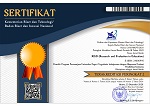An evaluation of the Petty Officer Training program of the Republic of Indonesia police using the Kirkpatrick model
Langgeng Purnomo, Human Resources Staffing of Indonesian National Police Headquarter, Indonesia
Abstract
Keywords
Full Text:
PDFReferences
Allen, M. J., & Yen, W. M. (1979). Introduction to measurement theory. Brooks/Cole.
Decree of the Chief of Indonesian National Police No. KEP/2513/XII/2019 concerning the Implementation of Indonesian Police Pre-Petty Officer Recruitment in the Indonesian Police Petty Officer Recruitment in the 2020 Budget Year, (2019).
Ghozali, I. (2006). Aplikasi analisis multivariate dengan program SPSS. Badan Penerbit Universitas Diponegoro.
Gujarati, D. N., & Porter, D. C. (2009). Basic econometrics (5th ed.). McGraw-Hill.
HemmatiMaslakpak, M., Farhadi, M., & Fereidoni, J. (2016). The effect of neuro-linguistic programming on occupational stress in critical care nurses. Iranian Journal of Nursing and Midwifery Research, 21(1), 38–44. https://doi.org/10.4103/1735-9066.174754
Huehls, F. (2010). Literature review. International Journal of Educational Advancement, 10(1), 48–55. https://doi.org/10.1057/ijea.2010.1
Kirkpatrick, D. L. (1998). Evaluating training programs: The four levels. Berrett-Koehler.
Kirkpatrick, Donald L., & Kirkpatrick, J. D. (2006). Implementing the four levels: A practical guide for effective evaluation of training programs. Berrett-Koehler.
Kolb, A. Y., & Kolb, D. A. (2005). Learning styles and learning spaces: Enhancing experiential learning in higher education. Academy of Management Learning & Education, 4(2), 193–212. https://doi.org/10.5465/amle.2005.17268566
Law No. 2 of 2002 concerning Indonesian National Police, (2002).
Letter of Assignment of the Chief of Indonesian National Police No. Sprin/1637/VI DIK.2.1/2020/SSDM concerning the Implementation of Noken Coaching and Training TOT for Petty Officer in the Indonesian Police Recruitment of 2020 Budget Year, (2020).
Nunnally, J. C., & Bernstein, I. H. (1994). Psychometric theory (3rd ed.). McGraw-Hill. https://books.google.co.id/books/about/Psychometric_Theory_3E.html?id=_6R_f3G58JsC&redir_esc=y
Pituch, K. A., & Stevens, J. P. (2016). Applied multivariate statistics for the social sciences: Analyses with SAS and IBM’s SPSS (6th ed.). Routledge. https://www.routledge.com/Applied-Multivariate-Statistics-for-the-Social-Sciences-Analyses-with-SAS/Pituch-Stevens/p/book/9780415836661
Priyatno, D. (2010). Paham analisa statsitik data dengan SPSS. MediaKom.
Ramadhon, S. (2016). Penerapan model empat level Kirkpatrick dalam evaluasi program pendidikan dan pelatihan aparatur di Pusdiklat Migas. Swara Patra: Majalah Ilmiah PPSDM Migas, 6(1), 43–54. http://ejurnal.ppsdmmigas.esdm.go.id/sp/index.php/swarapatra/article/view/101
Seysener, L. (2011). Time line therapy®: An advanced technique from the science of neuro linguistic programming. Australian Journal of Clinical Hypnotherapy and Hypnosis, 32, 40–48.
Sudjana, S. (2005). Metode statistika. Tarsito.
Sugiyono, S. (2013). Metode penelitian kuantitatif, kualitatif, dan R & D. Alfabeta.
Sukestiyarno, S. (2015). Olah data penelitian berbantu SPSS. Universitas Negeri Semarang.
Sumantri, H., & Setiawan, E. (2019). Jati diri bangsa: Kyai Muchammad Muchtar Mu’thi sang mujadid wawasan kebangsaan (2nd ed.). Organisasi Shiddiqiyyah.
Tan, K., & Newman, E. J. (2013). The evaluation of sales force training in retail organizations: A test of Kirkpatrick’s four-level model. , 30, 692. The International Journal of Management, 30(2), 692–703. https://www.proquest.com/openview/db1da765340d369f440d54bf7271a384/1.pdf?pq-origsite=gscholar&cbl=5703
Tosey, P., Mathison, J., & Michelli, D. (2005). Mapping transformative learning: The potential of neuro-linguistic programming. Journal of Transformative Education, 3(2), 140–167. https://doi.org/10.1177/1541344604270233
DOI: https://doi.org/10.21831/reid.v7i2.36937
Refbacks
- There are currently no refbacks.

This work is licensed under a Creative Commons Attribution-ShareAlike 4.0 International License.







.png)







